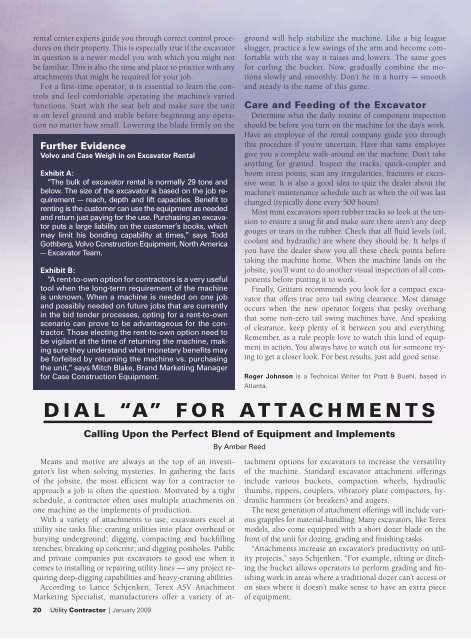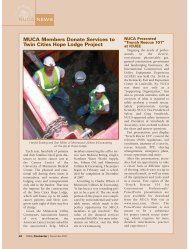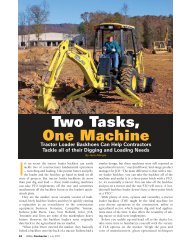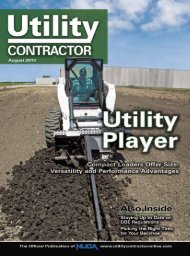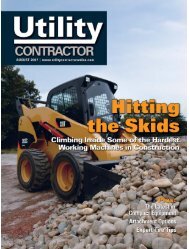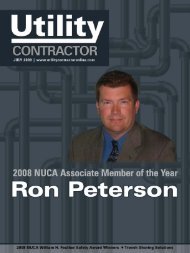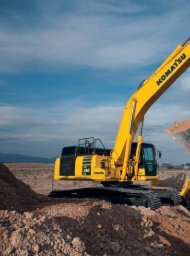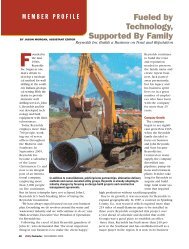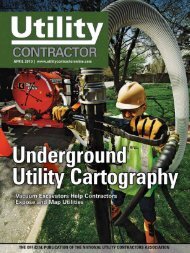View Full January PDF Issue - Utility Contractor Online
View Full January PDF Issue - Utility Contractor Online
View Full January PDF Issue - Utility Contractor Online
You also want an ePaper? Increase the reach of your titles
YUMPU automatically turns print PDFs into web optimized ePapers that Google loves.
ental center experts guide you through correct control procedureson their property. This is especially true if the excavatorin question is a newer model you with which you might notbe familiar. This is also the time and place to practice with anyattachments that might be required for your job.For a first-time operator, it is essential to learn the controlsand feel comfortable operating the machine’s variedfunctions. Start with the seat belt and make sure the unitis on level ground and stable before beginning any operationno matter how small. Lowering the blade firmly on theFurther EvidenceVolvo and Case Weigh in on Excavator RentalExhibit A:“The bulk of excavator rental is normally 29 tons andbelow. The size of the excavator is based on the job requirement— reach, depth and lift capacities. Benefit torenting is the customer can use the equipment as neededand return just paying for the use. Purchasing an excavatorputs a large liability on the customer’s books, whichmay limit his bonding capability at times,” says ToddGothberg, Volvo Construction Equipment, North America— Excavator Team.Exhibit B:“A rent-to-own option for contractors is a very usefultool when the long-term requirement of the machineis unknown. When a machine is needed on one joband possibly needed on future jobs that are currentlyin the bid tender processes, opting for a rent-to-ownscenario can prove to be advantageous for the contractor.Those electing the rent-to-own option need tobe vigilant at the time of returning the machine, makingsure they understand what monetary benefits maybe forfeited by returning the machine vs. purchasingthe unit,” says Mitch Blake, Brand Marketing Managerfor Case Construction Equipment.ground will help stabilize the machine. Like a big leagueslugger, practice a few swings of the arm and become comfortablewith the way it raises and lowers. The same goesfor curling the bucket. Now, gradually combine the motionsslowly and smoothly. Don’t be in a hurry — smoothand steady is the name of this game.Care and Feeding of the ExcavatorDetermine what the daily routine of component inspectionshould be before you turn on the machine for the day’s work.Have an employee of the rental company guide you throughthis procedure if you’re uncertain. Have that same employeegive you a complete walk-around on the machine. Don’t takeanything for granted. Inspect the tracks, quick-coupler andboom stress points; scan any irregularities, fractures or excessivewear. It is also a good idea to quiz the dealer about themachine’s maintenance schedule such as when the oil was lastchanged (typically done every 500 hours).Most mini excavators sport rubber tracks so look at the tensionto ensure a snug fit and make sure there aren’t any deepgouges or tears in the rubber. Check that all fluid levels (oil,coolant and hydraulic) are where they should be. It helps ifyou have the dealer show you all these check points beforetaking the machine home. When the machine lands on thejobsite, you’ll want to do another visual inspection of all componentsbefore putting it to work.Finally, Grittani recommends you look for a compact excavatorthat offers true zero tail swing clearance. Most damageoccurs when the new operator forgets that pesky overhangthat some non-zero tail swing machines have. And speakingof clearance, keep plenty of it between you and everything.Remember, as a rule people love to watch this kind of equipmentin action. You always have to watch out for someone tryingto get a closer look. For best results, just add good sense.Roger Johnson is a Technical Writer for Pratt & Buehl, based inAtlanta.DIAL “A” FOR ATTACHMENTST A T Calling Upon the Perfect Blend of Equipment and ImplementsBy Amber ReedMeans and motive are always at the top of an investigator’slist when solving mysteries. In gathering the factsof the jobsite, the most efficient way for a contractor toapproach a job is often the question. Motivated by a tightschedule, a contractor often uses multiple attachments onone machine as the implements of production.With a variety of attachments to use, excavators excel atutility site tasks like: craning utilities into place overhead orburying underground; digging, compacting and backfillingtrenches; breaking up concrete; and digging postholes. Publicand private companies put excavators to good use when itcomes to installing or repairing utility lines — any project requiringdeep-digging capabilities and heavy-craning abilities.According to Lance Schjenken, Terex ASV AttachmentMarketing Specialist, manufacturers offer a variety of attachmentoptions for excavators to increase the versatilityof the machine. Standard excavator attachment offeringsinclude various buckets, compaction wheels, hydraulicthumbs, rippers, couplers, vibratory plate compactors, hydraulichammers (or breakers) and augers.The next generation of attachment offerings will include variousgrapples for material-handling. Many excavators, like Terexmodels, also come equipped with a short dozer blade on thefront of the unit for dozing, grading and finishing tasks.“Attachments increase an excavator’s productivity on utilityprojects,” says Schjenken. “For example, tilting or ditchingthe bucket allows operators to perform grading and finishingwork in areas where a traditional dozer can’t access oron sites where it doesn’t make sense to have an extra pieceof equipment.20 <strong>Utility</strong> <strong>Contractor</strong> | <strong>January</strong> 2009


